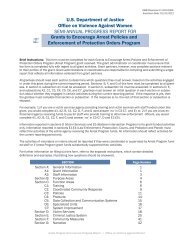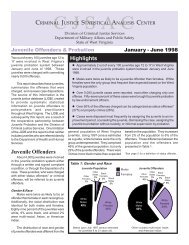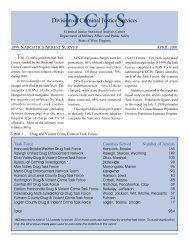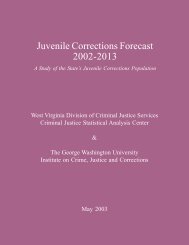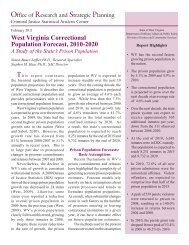The Use of Core Correctional Practices in Offender Reentry and ...
The Use of Core Correctional Practices in Offender Reentry and ...
The Use of Core Correctional Practices in Offender Reentry and ...
- No tags were found...
You also want an ePaper? Increase the reach of your titles
YUMPU automatically turns print PDFs into web optimized ePapers that Google loves.
Effective Service Delivery• A grow<strong>in</strong>g body <strong>of</strong> research <strong>in</strong>dicates that how servicesare provided may be as important as what is done.• How <strong>in</strong>terventions are delivered has been shown toimpact an <strong>of</strong>fender’s engagement <strong>in</strong> treatment as well assubsequent outcomes.• Generally, service delivery practices should: Be consistent with the pr<strong>in</strong>ciple <strong>of</strong> general responsivity (i.e.,cognitive-behavioral approach); Incorporate elements <strong>of</strong> empirically-supported core correctionalpractices.
<strong>Core</strong> <strong>Correctional</strong> <strong>Practices</strong>(Adapted from Andrews, 2000; Dowden & Andrews, 2004)• Andrews <strong>and</strong> Kiessl<strong>in</strong>g (1980) identified five dimensions<strong>of</strong> effective correctional <strong>in</strong>tervention: Appropriate <strong>Use</strong> <strong>of</strong> Authority Appropriate Model<strong>in</strong>g <strong>and</strong> Re<strong>in</strong>forcement Skill-build<strong>in</strong>g <strong>and</strong> Problem Solv<strong>in</strong>g Strategies Effective <strong>Use</strong> <strong>of</strong> Community Resources Relationship Factors• Recent meta-analytic research by Dowden <strong>and</strong> Andrews(2004) found: Programs that conta<strong>in</strong>ed elements <strong>of</strong> CCP were associated withgreater reductions <strong>in</strong> recidivism (i.e., substantially higher meaneffect sizes) compared to those that did not.
<strong>Core</strong> <strong>Correctional</strong> <strong>Practices</strong>(Adapted from Andrews, 2000; Dowden & Andrews, 2004)• Appropriate use <strong>of</strong> authority: “Firm but fair” approach with <strong>of</strong>fenders. Direct, specific communication <strong>of</strong> dem<strong>and</strong>s <strong>and</strong> rules. Monitor progress <strong>and</strong> reward compliance with rules, giveencourag<strong>in</strong>g messages, <strong>and</strong> support words with action. Respectfully guide <strong>of</strong>fenders toward compliance. Refra<strong>in</strong> from controll<strong>in</strong>g <strong>and</strong> sham<strong>in</strong>g discipl<strong>in</strong>ary practices. Focus message on the behavior, not the prisoner.• Appropriate model<strong>in</strong>g <strong>and</strong> re<strong>in</strong>forcement: Staff engages <strong>in</strong> pro-social model<strong>in</strong>g <strong>and</strong> role-play<strong>in</strong>g <strong>Use</strong> positive re<strong>in</strong>forcement & effective disapproval techniques Demonstrate <strong>and</strong> re<strong>in</strong>force appropriate alternatives to procrim<strong>in</strong>alstyles <strong>of</strong> th<strong>in</strong>k<strong>in</strong>g, feel<strong>in</strong>g <strong>and</strong> act<strong>in</strong>g. Engage <strong>in</strong> structured learn<strong>in</strong>g procedures (use <strong>of</strong> roleplay<strong>in</strong>g/rehearsal, model<strong>in</strong>g, <strong>and</strong> provid<strong>in</strong>g appropriate feedbackon <strong>in</strong>mate performance).
<strong>Core</strong> <strong>Correctional</strong> <strong>Practices</strong>(Adapted from Andrews, 2000; Dowden & Andrews, 2004)• Skill-build<strong>in</strong>g <strong>and</strong> problem solv<strong>in</strong>g strategies: <strong>Use</strong> <strong>of</strong> structured learn<strong>in</strong>g <strong>and</strong> cognitive-behavioral techniques. Foster skill development <strong>and</strong> improve the problem-solv<strong>in</strong>g ability. Seek to identify <strong>in</strong>mate problems, help <strong>in</strong>mates generatealternatives, <strong>and</strong> develop an implementation plan.• Effective use <strong>of</strong> community resources: Advocacy <strong>and</strong> brokerage Connect to help<strong>in</strong>g agencies that provide support or <strong>in</strong>terventionbased services (e.g., substance abuse treatment or employmentservices).• Relationship factors: Quality <strong>of</strong> staff-<strong>in</strong>mate relationships. Relate <strong>in</strong> open, respectful, car<strong>in</strong>g, <strong>and</strong> genu<strong>in</strong>e ways. Empathic, competent <strong>and</strong> committed to help<strong>in</strong>g the <strong>of</strong>fender.
CCP <strong>and</strong> Preparedness for Release• Some prelim<strong>in</strong>ary <strong>in</strong>dications that <strong>in</strong>dividual attitudes <strong>and</strong>expectations <strong>of</strong> life after release may <strong>in</strong>fluence futureoutcomes.• In a qualitative analysis <strong>of</strong> the life narratives <strong>of</strong> exprisoners,Maruna (2001) discovered that compared topersist<strong>in</strong>g <strong>of</strong>fenders: Desist<strong>in</strong>g men <strong>and</strong> women held dramatically more positiveexpectations about their future <strong>and</strong> stronger senses <strong>of</strong> controlover their own lives.• He concluded that prisoners who expressed a morepositive outlook about their future may be less likely torecidivate, while prisoners who expressed a less positiveoutlook should be more likely to recidivate.
Present StudyData Collection:• Adm<strong>in</strong>istered a self-report questionnaire to sample <strong>of</strong>soon-to-be-released prisoners.• N = 496; 90-days from expected release• 11 <strong>in</strong>stitutions; <strong>in</strong>clud<strong>in</strong>g 2 work-release centers• Sample selection <strong>and</strong> adm<strong>in</strong>istration proceduresmodeled after recent research efforts (e.g., Steurer,Smith, <strong>and</strong> Tracy, 2001; Visher, La Vigne, <strong>and</strong> Castro,2003)• Response rate = 68.1% (496/728)
Inmate Surveys on Prison Performance<strong>and</strong> Conditions• Most studies <strong>in</strong> CCP have been based on observation <strong>of</strong>staff skills <strong>and</strong>/or program components. This study uses<strong>in</strong>mate survey responses.• Inmate surveys are commonly used to study a widerange <strong>of</strong> issues <strong>in</strong> corrections. Examples <strong>in</strong>clude: Crim<strong>in</strong>al history <strong>and</strong> other characteristics <strong>of</strong> <strong>in</strong>mates; Health <strong>and</strong> medical conditions <strong>of</strong> <strong>in</strong>mates; Prison adjustment issues <strong>of</strong> <strong>in</strong>mates; Prison victimization; <strong>and</strong> Prison environment.• In <strong>of</strong>fender reentry research- <strong>Use</strong>d to exam<strong>in</strong>e theexperiences <strong>of</strong> <strong>in</strong>mates prior to <strong>and</strong> dur<strong>in</strong>g <strong>in</strong>carcerationas well as their expectations for release.
Inmate Surveys on Prison Performance<strong>and</strong> Conditions• Recent research has centered on reliability <strong>and</strong> validityissues that surround <strong>in</strong>mate surveys (Camp, 1999;Camp, Gaes, Kle<strong>in</strong>-Saffran, Daggett, <strong>and</strong> Saylor, 2002;Logan, 1992).• <strong>The</strong>se studies provide evidence that <strong>in</strong>mate survey datacan be used to identify reliable measures thatdifferentiate prison performance <strong>and</strong> conditions.
Present StudyResearch Questions:• Are transitional services be<strong>in</strong>g provided to <strong>in</strong>mates <strong>in</strong> amanner that is consistent with core correctionalpractices?• To what extent do <strong>in</strong>mates feel prepared for release?• Are prisoner perceptions <strong>of</strong> the use <strong>of</strong> core correctionalpractices by staff positively associated with <strong>in</strong>matepreparedness for release?
Scale Descriptives
Appropriate <strong>Use</strong> <strong>of</strong> Authority by<strong>Correctional</strong> Staff
Effective <strong>Use</strong> <strong>of</strong> Model<strong>in</strong>g <strong>and</strong>Re<strong>in</strong>forcements by <strong>Correctional</strong> Staff
Cognitive Skill Build<strong>in</strong>g/Problem-Solv<strong>in</strong>gStrategies <strong>in</strong> <strong>Correctional</strong> Programm<strong>in</strong>g
Preparedness for ReleaseMeasures: Rooted <strong>in</strong> common barriers prisoners facedur<strong>in</strong>g re<strong>in</strong>tegration. High scores = <strong>in</strong>mates moreprepared for a given task.• Prepared to get a job• Comfortable return<strong>in</strong>g to family• Comfortable with hous<strong>in</strong>g situation• Know where they are go<strong>in</strong>g to live• Know what is expected <strong>of</strong> them• Will be easy to pay bills• Easy to f<strong>in</strong>d a good place to live• Have people to depend on (support)• Preparedness for release scale
Inmate Rat<strong>in</strong>gs <strong>of</strong> Preparedness forRelease
Correlations <strong>of</strong> CCP <strong>and</strong> InmatePreparedness for ReleaseEffective <strong>Use</strong> <strong>of</strong> AuthorityAppropriate Model<strong>in</strong>g <strong>and</strong>Re<strong>in</strong>forcement<strong>Use</strong> <strong>of</strong> Skill Build<strong>in</strong>g <strong>and</strong>Problem-Solv<strong>in</strong>g StrategiesEffective <strong>Use</strong> <strong>of</strong> CommunityResourcesQuality <strong>of</strong> InterpersonalRelationshipsPreparedness forRelease Scale.190***.188***.262***.166***.177****p < .001
Conclusions• Generally, the results imply that the WVORI couldbenefit from greater adherence to CCP.• Application <strong>of</strong> CCP is not as widely spread as one mighthope, at least from the perspectives <strong>of</strong> <strong>in</strong>mates.• Found high level <strong>of</strong> prison structure, but the quality <strong>of</strong><strong>in</strong>terpersonal relationships between staff <strong>and</strong> <strong>in</strong>mateswas poor. Many <strong>in</strong>mates felt staff used control <strong>and</strong> sham<strong>in</strong>g practices. Staff-<strong>in</strong>mate relationships were not characterized as car<strong>in</strong>g,open, <strong>and</strong> trust<strong>in</strong>g by many prisoners.
Conclusions• Many prisoners reported that they were <strong>of</strong>ten given theopportunity to practice new behaviors <strong>in</strong> prison. Over one-third <strong>of</strong> <strong>in</strong>mates reported a high level <strong>of</strong> role-play<strong>in</strong>g <strong>and</strong>/orrehearsal <strong>of</strong> new behaviors <strong>and</strong> skills <strong>in</strong> their prison programs.• Inmates did not believe appropriate behaviors weredemonstrated for them by correctional staff nor thatre<strong>in</strong>forcements were provided by prison staff.• Few <strong>in</strong>mates felt staff engaged <strong>in</strong> an effective use <strong>of</strong>community resources Little advocacy or brokerage on their behalf.• Substantial proportion <strong>of</strong> <strong>in</strong>mates felt that staff: Had not adequately helped them to develop a workable plan for release; Did not view their problems realistically; <strong>and</strong> Were given little assistance <strong>in</strong> putt<strong>in</strong>g their plans for release <strong>in</strong>to action.
Conclusions• As <strong>in</strong>mate perception <strong>of</strong> proper service delivery<strong>in</strong>creased, so did the belief that they were prepared forrelease.• This lends support for the notion that adher<strong>in</strong>g to CCPswith<strong>in</strong> the context <strong>of</strong> <strong>of</strong>fender reentry will better prepare<strong>in</strong>mates for release.• L<strong>in</strong>k is important because <strong>in</strong>dividual attitudes <strong>and</strong>expectations <strong>of</strong> life after release may impact <strong>and</strong> futureoutcomes (Maruna, 2001). Desist<strong>in</strong>g ex-prisoners had more positive expectations abouttheir future <strong>and</strong> stronger senses <strong>of</strong> control over their own lives.
Implications• WVDOC adm<strong>in</strong>istrators should work to f<strong>in</strong>d ways toenhance <strong>of</strong>fender expectations <strong>and</strong> preparedness forrelease.• WVDOC should focus more attention on thecharacteristics <strong>of</strong> staff <strong>and</strong> the specific techniques staffmembers utilize to deliver reentry services.• Staff characteristics <strong>and</strong> tra<strong>in</strong><strong>in</strong>g <strong>in</strong> core skills should beaddressed to ensure the maximum therapeutic impact <strong>of</strong>the WVORI.
PublicationHaas, Stephen M. <strong>and</strong> Cynthia A. Hamilton (2007, May).<strong>The</strong> <strong>Use</strong> <strong>of</strong> <strong>Core</strong> <strong>Correctional</strong> <strong>Practices</strong> <strong>in</strong> <strong>Offender</strong><strong>Reentry</strong>: <strong>The</strong> Delivery <strong>of</strong> Service Delivery <strong>and</strong> PrisonerPreparedness for Release. Charleston, WV: Mounta<strong>in</strong>State Crim<strong>in</strong>al Justice Research Services.Available onl<strong>in</strong>e: BJA Center for Program Evaluationhttp://www.ojp.usdoj.gov/BJA/evaluation/
ContactStephen M. Haas, Ph.D.Director, WV Statistical Analysis CenterPhone: 304-558-8814Email: Stephen.M.Haas@wv.govWeb Address: www.wvdcjs.com



